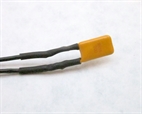
2amp Polyswitch fuse
Details
Polyswitches are widely used in computers, industrial equipment, electronics and communications equipment. Fuses are used in domestic electricity supplies to protect people from electrocution and also to help prevent fires from wiring becoming overheated. In low voltage applications, such as a radio controlled locomotive, the purpose of the fuse is to help safeguard sensitive electronic equipment but more significantly to protect batteries from potentially dangerous short circuits. Because rechargable batteries have very low internal resistance, current can flow rapidly from one terminal to the other thereby generating very high temperatures which can lead to explosive consequences - particularly with lithium-ion batteries. However, lithium-ion batteries need additional protection against being over-charged and over-discharged and so I would recommend either using 'protected' li-ion batteries or investing in battery protection boards if you intend to use lithium ion batteries. There is plenty of information on the internet about battery protection for lithium batteries.
At least one fuse should be used in the circuitry of any battery powered locomotive
The Polyswitch is a resettable fuse - more fully described as a "polymeric positive temperature coefficient (PPTC)" device. It is used to protect sensitive electronic equipment and batteries against short circuit, excess surges in current and excess temperature. The polyswitch can be used as a replacement for the more traditional type of fuse by limiting high currents caused by faults. Unlike a traditional fuse, the Polyswitch will automatically reset itself once the fault is remedied. The fuse offers some protection against overload for the receiver/ESC but cannot be guaranteed to protect sensitive electronic circuitry from all eventualities. Although rated at 2A, the fuse will restrict the current progressively as the load increases towards 3A.
During normal operations the Polyswitch has a resistance of about 0.07ohms which hardly affects the flow of current in the circuit. When a fault occurs in the circuit, the temperature and resistance of the fuse increases significantly, thereby restricting the current flow to almost zero. Once the fault has been rectified, the fuse cools down and the resistance returns to its normal level.
The Polyswitch can be placed anywhere in a circuit. When used inside battery powered, radio controlled model locos, I would suggest placing the Polyswitch as near to the battery as possible to ensure all wiring, components and the battery itself are protected from accidental short circuits. Conventionally, the fuse is placed in the positive supply lead from the battery, but with low voltage circuitry the fuse could be placed in either the negative or positive supply leads. There are some who suggest a fuse is more effective when placed in the negative supply lead from the battery as it can help to discourage the build-up of salts on the lead.
Polyswitches are widely used in computers, industrial equipment, electronics and communications equipment. Fuses are used in domestic electricity supplies to protect people from electrocution and also to help prevent fires from wiring becoming overheated. In low voltage applications, such as a radio controlled locomotive, the purpose of the fuse is to help safeguard sensitive electronic equipment but more significantly to protect batteries from potentially dangerous short circuits. Because rechargable batteries have very low internal resistance, current can flow rapidly from one terminal to the other thereby generating very high temperatures which can lead to explosive consequences - particularly with lithium-ion batteries. However, lithium-ion batteries need additional protection against being over-charged and over-discharged and so I would recommend either using 'protected' li-ion batteries or investing in battery protection boards if you intend to use lithium ion batteries. There is plenty of information on the internet about battery protection for lithium batteries.
At least one fuse should be used in the circuitry of any battery powered locomotive
The Polyswitch is a resettable fuse - more fully described as a "polymeric positive temperature coefficient (PPTC)" device. It is used to protect sensitive electronic equipment and batteries against short circuit, excess surges in current and excess temperature. The polyswitch can be used as a replacement for the more traditional type of fuse by limiting high currents caused by faults. Unlike a traditional fuse, the Polyswitch will automatically reset itself once the fault is remedied. The fuse offers some protection against overload for the receiver/ESC but cannot be guaranteed to protect sensitive electronic circuitry from all eventualities. Although rated at 2A, the fuse will restrict the current progressively as the load increases towards 3A.
During normal operations the Polyswitch has a resistance of about 0.07ohms which hardly affects the flow of current in the circuit. When a fault occurs in the circuit, the temperature and resistance of the fuse increases significantly, thereby restricting the current flow to almost zero. Once the fault has been rectified, the fuse cools down and the resistance returns to its normal level.
The Polyswitch can be placed anywhere in a circuit. When used inside battery powered, radio controlled model locos, I would suggest placing the Polyswitch as near to the battery as possible to ensure all wiring, components and the battery itself are protected from accidental short circuits. Conventionally, the fuse is placed in the positive supply lead from the battery, but with low voltage circuitry the fuse could be placed in either the negative or positive supply leads. There are some who suggest a fuse is more effective when placed in the negative supply lead from the battery as it can help to discourage the build-up of salts on the lead.
Specification
Product PPTC Resettable Fuse
Max. Voltage 16V
Max. Current 2A
Pin Dia. 0.59mm (0.02")
Pin Spacing 4.7mm (0.18")
Body Size 10 x 5.5mm (0.4" x 0.22"(LxW))
Total Size 21 x 5.5 x1.5mm (0.83" x 0.22" x 0.06"(LxWxH))

